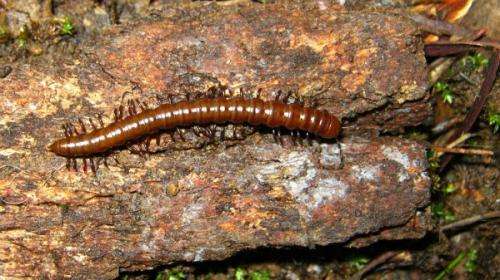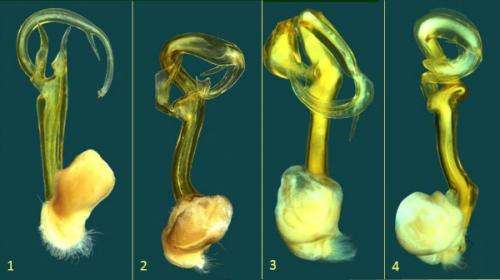Male sex organ distinguishes 30 millipede species

The unique shapes of male sex organs have helped describe thirty new millipede species from the Great Western Woodlands in the Goldfields, the largest area of relatively undisturbed Mediterranean climate woodlands in the world.
Western Australian Museum research associate Dr Catherine Car described these species that all belong to the genus Antichiropus, raising the number in WA from nine to 39.
Dr Car says species are distinguished by differences in the male gonads or 'gonopods', which are golden-coloured, paired structures, easily seen on the underside of the seventh body segment.
"The solenomere is the long twirly bit on the gonopod that disperses the sperm and has a distinctive shape per species," Dr Car says.
"There are also a number of processes or distinctive lumps, bumps and spikes on the solenomere that are used in mating that can assist us in species identification."
Dr Car says, although only 39 species have been formally described, the genus Antichiropus has been extensively collected and examined with 160 species known to occur across most of Western Australia south of the Kimberley.
"These millipedes are remarkable: as litter dwellers, they are generally susceptible to desiccation, but they are able to survive in small localised areas of suitable microclimate even in semi-arid regions.
"They also bury up to a metre underground in dry conditions, returning to the surface to feed and mate when damp conditions return.

"A week or so after rain is the ideal time for collecting specimens and potentially more new species," Dr Car says.
Antichiropus species also have distinct and restricted ranges which do not overlap at small ecological scales.
"These restricted ranges make them very vulnerable to disturbances, which is a big concern when there are developments and mining ventures wanting to go ahead," Dr Car says.
Dr Car says the actual naming of each new species is the most fun.
Names are constructed from Latin and can be based on the locality of the species', on a person's name or on species' characteristics.
"For example, Antichiropus cincinnus is named after the Latin cincinnus meaning 'lock of hair' which, in this species, describes the solenomere. Antichiropus cavernus is found only in caves," Dr Car says.
Images were produced using the WA Museum's automontage system which captures and combines a series of images to build one 3D type image.
Provided by Science Network WA



















